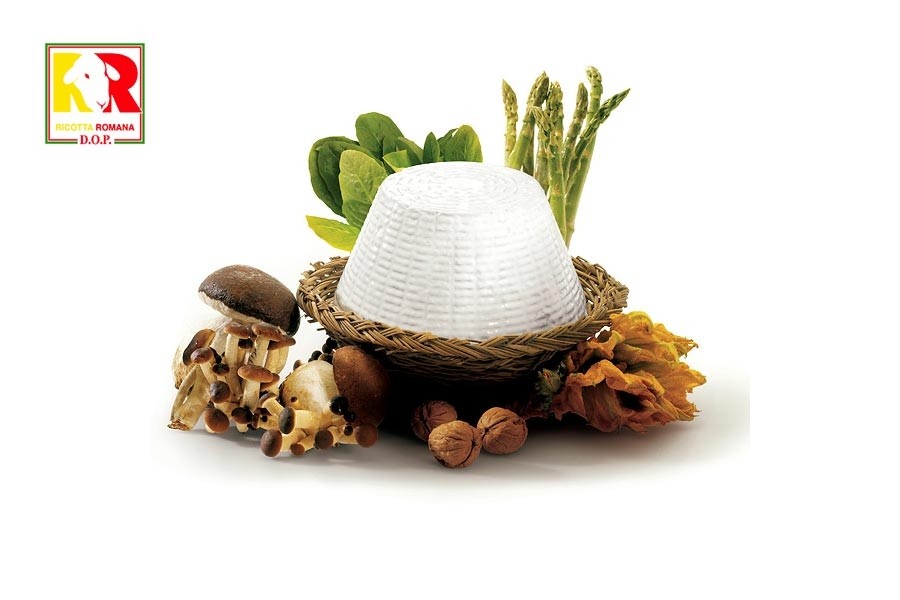Ricotta Cheese Romana P.D.O.
Product description
Ricotta Romana PDO is a fresh milk product obtained with whole sheep’s milk whey obtained from animals belonging to the Sarda, Comisana, Sopravissana and Massese breeds and their cross-breeds; the sheep must originate from the Lazio region and be pasture-grazed or fed on forage that grows in the region.
Production method
The sheep whey, without the addition of acidulants, is heated at a temperature of between 50-60°C and maintained in slight agitation.
During this stage, whole sheep’s milk may be added (up to 15% of the total volume of the whey).
Further heating to a temperature of 85-90°C promotes the forming and curdling of the whey protein, which comes to the surface in the form of small flakes.
The superficial consolidation of the flakes in layers occurs by stopping the heating process for around five minutes.
The layers of flakes are separated from the excess liquid, known as a scotta, and the ricotta is collected and put in perforated straw conical-ended molds for 8-24 hours, which stimulates further purging of the whey. The drained product is left to dry in a cool place, with a temperature of about +4°C.
Apparence ad flavour
Ricotta Romana PDO is white, lumpy with a characteristic sweet milky taste.
Gastronomy
Ricotta Romana PDO can be kept for a couple of days at 4-5°C.
The cheese can be eaten on its own, better if very fresh, or used as an ingredient in the preparation of several recipes and fillings.
It is particularly recommended with rye bread, dill bread or home-made bread.
The product is usually served with local, light white or rosé wine, among which, Circeo PDO Rosato or Colli della Sabina PDO.
Marketing
The product is marketed as Ricotta Romana PDO.
It is sold year-round in cone-ended plastic baskets weighing no more than 2 kg, or wrapped in parchment, vacuum-packed and/or in plastic containers.
Distinctive features
The sheep’s particular diet, which mainly consists of typical grassland and pastures in the geographical production area, influences the quantity of lactose in the milk whey (no less than 3,55 %).
This attribute gives Ricotta Romana PDO the sweetish taste that distinguishes it.
History
The origins of Ricotta Romana PDO date back to ancient times.
As Cato states in his works referring to the regulations for sheep farming in the Roman Republic, sheep’s milk had numerous functions: from religious and sacrificial to nourishment, either as a drink or transformed into cheese or ricotta, for which excess whey was used.
There are numerous historical documents testifying to the diffusion of ricotta as a common food.
Lucio Giunio Moderato Columella, Roman agricultural writer of the I Century A.C., describes the various methods of obtaining this product in his book, De re rustica. According to Mauro Vizzardi, the author of Formaggi Italiani, although ricotta may originate from Roman agriculture, its diffusion was thanks to S. Francesco d’Assisi, who, in 1223, taught the specific production processes to shepherds in the Lazio area. Galen, in Della natura et vertu di cibi (1572), wrote: “that which for Galen and the Greeks was known as oxygala, is that which we now call ricotta”. In more recent times, Ercole Metalli, in his book Usi e costumi della campagna romana, tells how at the beginning of the 1900s, ricotta still represented practically the only food source for the shepherds of Lazio. In the same volume, he describes the production techniques of ricotta and the widespread habit of eating it with bread.
Production area
The production area of Ricotta Romana PDO is within the administrative territory of the Lazio region.
Operators: 92
Production(KG): 114.830
Turnover(MLN€): 0,62

 IT
IT 